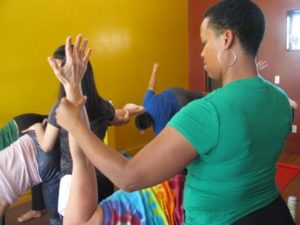Does yoga cause injuries?
That’s the question.
There have been some articles lately with gurus and teachers confessing the error of their ways of teaching and practicing, begging forgiveness for injuries and throwing yoga under the bus saying it’s actually harmful to our health rather than restorative, healing and good.
“How Yoga can Wreck your Body” – New York Times
Yoga, all eight limbs, is designed to be a balanced, integrative system toward connecting our physical selves with our spiritual selves.
To me, does yoga as a practice itself hurt people?
No.
People hurt people.
TEACHERS
Poor attentiveness and training and skill for the needs of our students on the part of teachers.
It’s the teacher’s room. It’s their responsibility. What they teach becomes what the student practices.
There are a lot of teachers who teach ONE way and expect the masses to adapt to them. Either they teach a very rigid form of yoga that is strict about doing certain poses in a certain order all the time, or they are just rigid, disciplined types of teachers.
Offering choices is key:
Kintla Ernst, Kintla Yoga, East Lansing, Michigan: “The intention and the language of the teacher cannot be underestimated. Offering a safe space for students to feel empowered to make *choices* for their own bodies in a yoga class is a fundamental basis for avoiding injuries and for accessing the multifaceted healing benefits of yoga.”
I’m fortunate not to have had any injuries in my class or studio that I know of.
Just as my personal yoga practice has matured, evolved and changed over time, so has my yoga teaching practice.
And yes, teaching is a practice.
It’s a practice of mindfulness, presence, compassion and knowledge of anatomy, asana and more. It’s all of it at once.
I started teaching power yoga and vinyasa in a set way. It was almost a script.
Then I opened a community class and had a room full of people who had never done yoga. Some were overweight. Some had back problems and even fused vertebrae.
I got scared.
I didn’t want to hurt anyone. And I didn’t want to let them down.
It’s like watching people come to you to heal all their woes.
“My doctor told me yoga could fix (fill in the blank).”
“My daughter’s been on me for years to do yoga for my stress.”
“My friend said it would help me lose weight.”
Then, there they are in my room.
In my first class I modified like crazy and threw the script out the door. I worried the rythm of the class was off, that I sounded awkward when I paused to think of what EVERYONE could do safely.
But that concern was truly only in my head.
Everyone was fine in the room with the pace and tempo and options I offered because I was their FIRST yoga teacher.
And what I ended up with – a focus on their safety and wellbeing, a focus on teaching the class in a way so everyone could do the poses created a cohesive group (no yogi left behind) – a community – started to define me as a teacher.
ADJUSTMENTS
Kim Lewis, Just B Yoga, 40+ yoga instructor: “Sometimes the ego gets in the way, and we worry about what the pose looks like and push the body into a dangerous space. Staying aware of what’s going on inside our own bodies keeps us 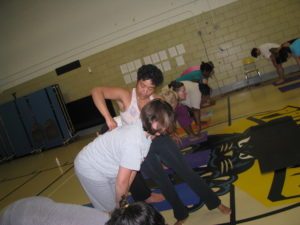
I feel that teachers should be cautious about giving adjustments until they know that student’s body and practice. I also believe that it could be dangerous to teach poses such as shoulder stand and inversions in a large class with many less experienced students. It’s really difficult for a teacher to check that all students are safe in this kind of classroom situation.
If we are mindful, we can practice yoga throughout our lives. Yoga recognizes that there are different stages in life and our practice will change as our bodies change. As we get older, we can adjust the way that we practice so that we keep the body strong and flexible without causing damage.”
I also used to be very hands-on with adjustments that deepened people into poses.
Now I tend to make more verbal adjustments for what’s safe for knees, hips, wrists, spines and let the deepening come from the student and not my adjustment. Not only are some people not into being touched, but they don’t need it. I do have some students who want some “love” in class, but I’m sparing with it and know it’s less about the yoga at that point and more about our personal relationship and our mutual understanding of their body’s abilities and needs.
New bodies need to be taught to listen to themselves. To learn their abilities and limits and fears.
Bodies that have been accustomed to practice might need to explore new frontiers of challenge, but most often I’m finding they need to learn to back off. Making less be more. Yoga isn’t a sport or an exercise, and it’s certainly not a competition. But many students approach it as a physical practice to hone or sharpen like a blade. But honestly, finding a longer time in an arm balance or doing a 5 minute boat pose won’t get you to samadhi or nirvana. But it might be doing something for our ego.
FLEXIBILITY
Let’s get flexible with flexibility.
I am starting to ask people more when they come to my room, what is flexible, when they say they’ve come for more flexibility.
Our popular culture and yoga magazines and web sites have propagated an image of yoga that is unreasonable and unhealthy when it comes to flexibility.
We are subjected to the image of bodies twisting and bending in excessive ways for the majority of us. (many of them are double jointed or have a range that is outside of the normal curve).
So many students come into yoga classes feeling THEY are abnormal or deficient. We can have limber bodies with a healthy range of motion. But some of us are aspiring to unnatural or unhealthy ranges of flexibility.
As Bryan Kest would say, there’s no evolutionary advantage to getting your foot behind your head. If there was, God would have put it there.
The students are all approaching yoga with different mindsets, some with a physical goal in mind either of how they want their bodies to look (getting skinny or muscularly cut) or the kinds of poses they want to be able to do (the crazier the better).
Other students are approaching yoga from a healing standpoint, either they’ve been injured or sick or they’re getting older and have some degenerative issues going on.
And still others are hoping for some stillness and stress-relief, maybe inner peace.
We should be teaching flexibility in our minds and hearts and focus less on the bodies.
LESS IS MORE
Janet MacFarlane, blogger “Maha Mamas” and Hilltop Yoga, prenatal and vinyasa yoga instructor: “Anything in excess, including yoga, can cause harm. Without mindfulness, it can be easy to hurt yourself. I tell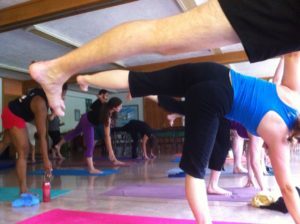
We don’t all need another backbend or arm balance.
We don’t all need another power yoga class.
Maybe we need to explore Yin for asana or pranayama and meditation practices to deepen our yoga.
Balance and honoring our bodies is key to connecting with our mind and spirit.
Can full urdva danurasana hurt your spine? Sure, if you’re not ready or if you’ve done it too much. And maybe your body isn’t ever going to accept that pose.
Can some twisting poses exacerbate a spinal disk issue? Sure, if you’re over rotating and yanking on your body by trying to get a bind.
Can you hurt your neck in shoulder stand, plow and head stands? Yes! And often the student and teacher should have never approached them in the first place.
I don’t know what my “style” of teaching is, other than to bring listening into all aspects of my teaching. I listen with my eyes, my heart and my head.
And I’m continuing to learn to modify and change for the students that walk into my room.
TEACHING IS PRACTICE
Teachers are not perfect. They are humans practicing just as the students are – we hope. If they are going to grown and improve, they will approach teaching mindfully and with compassion. Wise action. Wise intention. Wise view. Wise speech.
I close with two yogi friends I respect who shed light on teaching as practice.
Sybil Shelton-Ford, As You Are Yoga: “Asana practice, like any physical practice, can be dangerous if not executed well. I think that power based classes for total beginners is never a good idea. it always bothers me when vinyasa flow classes are marketed for “all fitness levels” or “no experience necessary”. I must say, that I have done this in the past and have drastically changed my teaching practice. When someone has no idea how to align their body in a pose, it makes absolutely no sense to teach them in a flow/power class. People never want to learn the basics. They just want to jump in and do the sexy stuff! I have known people to get hurt in such classes – especially when the teacher is green or the student insists on pushing.
Yes, I have been injured in my asana practice. I have had strained muscles, overuse injuries of the wrist and shoulders (from too many sun salutations) and the most serious – I have a loose ligament in my left SI joint from trying to ‘master’ open-hipped poses. Two of these injuries resulted in separate 6-week sessions in PT! And I knew better! The ego tends to be stoked for some people in power classes – this is why I do not teach them anymore. People tend to covet the poses of the teacher or more experienced students and this is problematic. As I said, it happened to me and I knew better.
Asana practice is meant to be an extension of a mindful practice. In order to be mindful, we must SLOW DOWN and go within. A good hatha practice allows people to do this while staying safe as long as the teacher understands the limits of the students and is not over zealous with adjustments or corrections. Once you have this understanding, you may graduate to vinyasa styles. This is the safest way. Also, it is important for people to vary their physical practices to avoid overuse injuries. I was a personal trainer before I was a yoga teacher and I learned the importance of creating muscle confusion and changing prescribed workouts after a certain period of time. Can we teach power classes while limiting the number of sun salutes? Can we challenge ourselves this way? What other vinyasas can we create to protect our students from such potential unhealthy repetitions? Encourage students to balance asana practice with some other type of movement practice – especially when you hear them say, “All I do is yoga”.
This is probably more than you wanted, but this is my view. Is yoga unhealthy? It can be!”
Tara Scott, of Dharma Yoga Arts, and an instructor with Just B Yoga: “Not every teacher is called to serve. So teaching yoga for some can be as much about ego, “doing,” and “performing” as it is in other fields.
The “no pain, no gain” philosophy still prevails so that “edges” become extremes rather than healthy boundaries that are to be approached with compassionate understanding and respect.
Since I began teaching nearly 7 years ago, my “students” have predominately been mature women and men (those who can afford to commit to a regular practice)–many of whom are struggling with the new realities (i.e. limitations) of their aging bodies. This demographic has dictated that I teach asana that are functional and, ultimately, emphasize sthiram & sukham. Those qualities of stability and ease have prevailed in my approach to integrating mindfulness & meditation with movement.
Out of respect for the life experience in the rooms where I was often the youngest, I couldn’t, nor did I desire to, demonstrate asana that were not accessible to those with whom I was sharing the practice. Not only did it invite me to look more deeply at the purpose of each pose, but also at my own intention in practicing and teaching any given posture. My flexibility as a teacher has come from offering modifications, variations, and the option to abstain and instead discover what one’s body needs from moment to moment. It has been a wonderful opportunity for me to cultivate self-acceptance and grace as I approach 40.
And this is what I have always understood my calling to this vocation to be: that I teach what I must learn and that what I teach is always teaching me. I don’t stand at the front of the room professing to know it all. I respect the reciprocity of the exchange of knowledge and wisdom. We are teaching each other. More often than not, I’ve recognized that (hard) lesson to be: truly embodying A-HIMSA & learning to use our practice of asana to undo the violence we do to ourselves and that which has been done unto us when we are off our mats.”
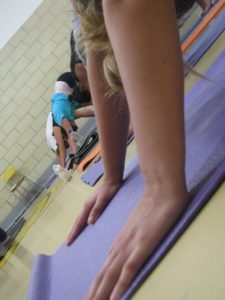
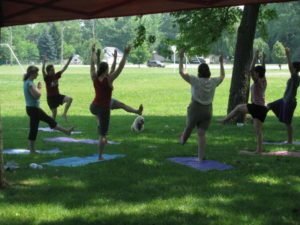
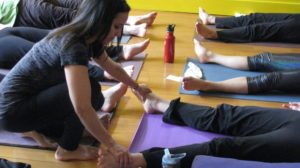
![[Photo by MATTHEW DAE SMITH | for LSJ]](https://justbyoga.com/wp-content/uploads/2013/05/yoga-feet-300x200.jpg)
